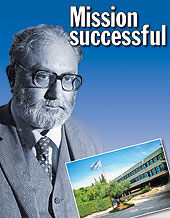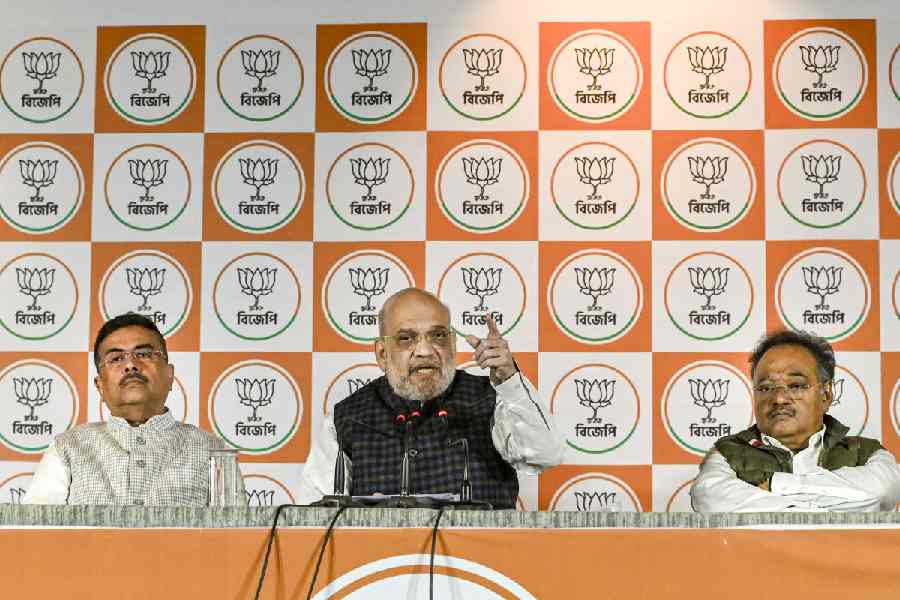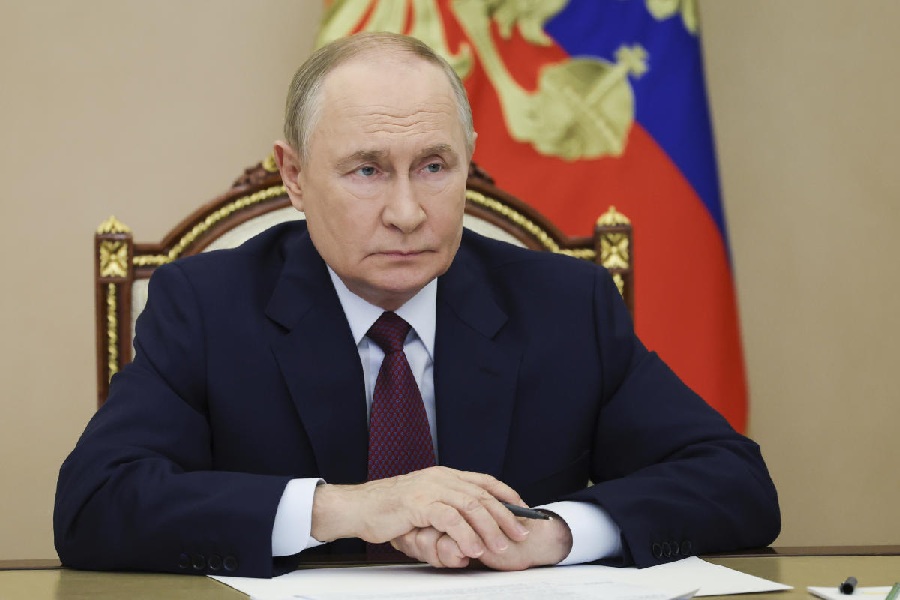 |
It?s a cloudy October morning at the Milan airport. The bus to ferry passengers to the aircraft for Alitalia?s flight 1339 to Trieste is slowly getting filled up. ?It seems everybody is going to the ICTP,? says Panamalai Ramrao Parthasarathy, mathematics professor at the IIT-Madras, looking at the lot that?s boarding the bus. ?Maybe you?re right,? comments the gentleman sitting next to him, ?I?m also going there. Let me introduce myself. I?m Ghulam Murtaza from the Government College, Lahore.?
Prof. Murtaza is an authority on the life and works of Abdus Salam, the Pakistani scientist who shared the 1979 Nobel prize in physics along with Sheldon Glashow and Steven Weinberg. As the bus trundles towards the aircraft, the two professors from India and Pakistan engage themselves in a discussion on Salam?s early life. ?Do you know that Salam?s first published paper was on a problem set by your Srinivasa Ramanujan?? Prof. Murtaza asks. ?Prof. Sarvadaman Chowla, Salam?s teacher at the Lahore College, once described the problem, daring his students to solve it. A few days later Salam came back with a solution, and later he wrote a paper on that.?
Prof. Murtaza then concentrates on the life of the teacher who honed Salam?s mathematical skills. ?After Independence, Chowla went to the Institute for Advanced Study in Princeton, US,? he tells Prof. Parthasarathy. ?And it was there that Chowla did that now-famous research with physicist Freeman Dyson,? comments the latter. ?They detected an uncanny link between the properties of prime numbers and atoms.?
The discussion continues even on board the flight to Trieste. Hardly surprising, for the stories of Ramanujan, Salam or Chowla are essentially the same: about genius from the East making a mark in the West. Like many other passengers in the aircraft, Prof. Parthasarathy and Prof. Murtaza are going to Trieste to attend the 40th anniversary celebrations of the International Centre for Theoretical Physics (ICTP). It was established at the initiative of Salam (which is why, after his demise in 1996, it?s been renamed as Abdus Salam ICTP) so that ?young physicists from the Third World countries can find a second home where they are treated with dignity and respect? (see story on Page 3). ?The centre?s inception marks it as a new type of venture ? an assay in collaboration for pure science organised under the aegis of the United Nations,? wrote Salam in Physics Today in 1965. ?The idea is the embodiment of the international ideal; it must succeed.? That prophecy has come true and the ICTP authorities have organised a two-day celebration, beginning October 4, inviting more than 150 scientists (as many as eight Nobel laureates among them) and statesmen from across the globe.
The programme, appropriately titled ?Legacy for the Future?, begins at the spacious lecture hall of the ICTP in the presence of ministers from the Italian government, dignitaries from the UNESCO, International Atomic Energy Agency (IAEA), mayor of Trieste and the Chairman of the Group of 77. At the outset, the ICTP director, Prof. Katepalli R. Sreenivasan, reads out messages from Pakistan?s President, Gen. Pervez Musharraf (a message from India?s Prime Minister, Dr Manmohan Singh, reaches late and is also read out by him during another session), and the director-general of UNESCO. He then briefly describes ICTP?s role in promoting R&D in the developing countries. To mark the 40th year of ICTP, he announces the institution of a couple of new prizes, including one in mathematics, to be called the ?Ramanujan Prize?. The funds for it, he says, have come from the Abel Foundation in Norway where Niels Henrik Abel, a genius mathematician, was born in the 18th century. Abel?s life bears close resemblance to that of Ramanujan in that he too was ignored in his own country and died young in utter poverty.
The plight of the developing countries figure prominently in the discussions at the ?Legacy for the Future?. Speaking on ?Rural Poverty in Poor Countries and the Local Environment?, Cambridge University economist Sir Partha Dasgupta shows why common indicators of the wealth of a nation, like the GDP or per-capita income, don?t necessarily reflect the well-being of its citizens.
In the panel discussion on ?International Cooperation and the Promotion of Science?, Prof. Chintamani .R. Rao, from the Jawaharlal Nehru Centre for Advanced Scientific Research, Bangalore, laments that many developing countries don?t even spend 0.1 per cent of their GDP for R&D. ?How will science flourish there?? he asks, pointing out that although India, China and Brazil harbour more than one-third of the world?s population, their scientists publish only 7-8 per cent of the papers in journals. ?Only 3-4 per cent of those papers are cited by others,? Prof. Rao comments. ?Let?s set a target for ourselves: 15 per cent citations within the next 10 years.?
Speaking on ?Science in the Developing World?, Prof. Ahmed Zewail, Nobel Prize-winning professor at the California Institute of Technology, says, ?We must get our house in order before blaming others for ignoring us. Political will is lacking in the Third World for progress in science.? He describes an incident in which a researcher in Egypt could get customs clearance for an imported instrument only after its warranty expired.
?Legacy for the Future? includes sessions that go beyond soul-searching. For example, in his lecture on ?Challenges for High Energy Physics?, Dr Luis Alvarez-Gaume, from the Counceil Europeen de Recherches Nucleaires (CERN), the particle accelerator near Geneva, discusses some of the conundrums of theoretical physics. One of them is the varying strengths of the different forces that operate in nature. For example, two electrons, being of the same negative charge, repel each other with a force. However, being particles with some mass (however small that may be), they also attract each other. Now, the repulsive force is 100,000,000,000,000,000, 000,000,000,000,000,000,000,000,000 times bigger than the attractive force. Why? Physicists have no clue to that puzzle yet. Similarly, physicists aren?t quite sure yet why particles have mass. A theory to explain this riddle assumes the existence of a class of particles, called ?Higgs? (after Dr Peter Higgs, the Scottish expert who put forward that theory), but no one has ?seen? a Higgs yet. Which is why CERN is preparing in a big way to catch one in 2008.
The audience bursts into laughter as Prof. Alvarez-Gaume, while discussing the string theory (experts? concept of a single idea to explain all physical phenomena), flashes a surrealist painting on the screen. It shows a castle on top of a huge piece of rock hanging in thin air! ?I want to convey the idea that the string theory has a rock-solid base,? he comments, highlighting critics? arguments that the theory is merely a mathematical artifact and has not been corroborated by experiments yet.
?Is there really such a final theory?? asks Dr Tuillo E. Regge, from the Institute for Scientific Interchange Foundation, Torino, Italy, in his lecture on ?The Very Small and the Very Large Structure of the Universe.? ?How boring it will be for scientists to discover such a theory. There will be no work left for us after that. I don?t think a single theory can ever explain all physical phenomena. I think our efforts to understand the complexities of nature will have no end. The show must go on.? Fielding a question from the audience as to whether the laws of nature are suited to the emergence of life in this Universe, Dr Regge comments, ?I don?t think so. I know some physicists are of that view. But that sounds like religious faith, not science. Not to be able to explain why the laws of nature are what they are is a failure of physics.?
The last scientific presentation is by Prof. John Forbes Nash who bagged the Nobel prize in economics in 1994. He?s probably the most famous of all Nobel-winners in the recent times, thanks to the gripping saga of his life. Having done his pioneering work ? the so-called ?Nash Equilibrium?, which is a kind of optimal strategy for games involving two or more players ? he fell prey to schizophrenia while still at the famed Institute for Advanced Study in Princeton, US. For several years he spent his days in and out of mental asylums and his wife, Alicia, stood by him during those hard times. Eventually, Nash came round and was awarded the Nobel. Their story was poignantly captured by the former New York Times economics correspondent Sylvia Nasar in A Beautiful Mind, the celluloid version of which ? directed by Ronald Howard, who cast Russell Crowe in the lead role ? won several Oscars.
By a strange coincidence, the film is shown on a movie channel the night before Nash is supposed to present his paper. And the scientists celebrating the 40th year of ICTP realise that Hollywood is a better ticket to fame than a call from Stockholm. The students from local schools and colleges swarm the auditorium ? many of them sit on the stairs of the aisle ? much before the appointed hour. And Nash gets an unprecedented ovation, a big hand as soon as he is called to the podium.
His paper, titled ?An Interesting Equation?, however, doesn?t match the overblown expectations, especially of the youngsters. For half an hour Nash discusses the so-called tensor geometry, the concept that Einstein employed to arrive at his celebrated General Theory of Relativity. Local press photographers have a field day with Nash beside a blackboard full of unintelligible squiggles, but the faces of the experts in the hall simply tell a different tale ? they can?t really fathom Nash?s brainwave.
Why? Nash claims to show that his ?interesting equation? makes quantum mechanics redundant as a description of nature. Relativity, he asserts, can explain all phenomena. ?I don?t understand quantum mechanics,? he comments with a touch of sarcasm, ?especially that bit of ?unknowable? attached to it. We all know that Einstein too didn?t like the concept.?
 |
| Big responsibility: ICTP director, Prof. Katepalli R. Sreenivasan |
Relativity describes the behaviour of stars, planets or falling apples, but it fails in the realm of the ultra-small ? subatomic particles. Although quantum mechanics reigns supreme in that world, many of its counterintuitive diktats baffle scientists, like the one that Nash finds so repugnant ? the idea that it?s impossible to know the exact position and velocity of any particle at a given instant. Physicists have lived with irritants of this kind for too many years now to fret about them, more so because experiments confirm the bizarre implications of the concept. Which is why hardly any serious question is hurled at Nash by the experts after his talk is over. They simply ignore his claim.
But that doesn?t minimise the applause as Nash comes down from the podium. And the audience starts dispersing, as if the hall were to empty. ?Ladies and gentlemen, the session isn?t over, we?ve to move on to the concluding part of our programme,? says Prof. Sreenivasan over the microphone.
His repeated pleadings finally work, and the closing session gets under way. A number of delegates, including Jafar Towfighi Darian, Iran?s minister for science, research and technology, are called to make brief remarks. All the speakers pay rich tributes to the ICTP for promoting R&D in the developing countries. Dr Spenta Wadia, from the Tata Institute of Fundamental Research (TIFR), Mumbai, who is currently working at CERN, expresses his gratitude to the ICTP for providing financial support for organising the world conference of the experts on the string theory at TIFR in January 2001. On a personal note, too, he says he is indebted to the IC-TP. ?It was during my stint here that I first met my wife,? he comments amidst uproarious laughter.
In his remarks, Mohammed Shamsher Ali, president, Bangladesh Academy of Sciences, recounts his days at the ICTP immediately after it was set up. ?Salam was a fatherly figure to all of us youngsters here in those days,? he says. ?He could be autocratic at times when it came to choosing research topics. We used to argue with him, but he would cut us short, often having the last word. However, he would soon appreciate our point and not hesitate to even apologise a moment later.? Salam, Ali claims, foresaw a big role for the ICTP in promoting R&D in Bangladesh. ?He visited our labs even in the last year of his life, although he was not keeping well then, and we looked to him for guidance and inspiration,? says Ali. ?Let the ICTP carry forward Salam?s dream.?
Responding to the shower of praise, Prof. Sreenivasan exudes modesty as well as confidence, saying, ?I?m a trifle scared when I think whether the Abdus Salam ICTP will live up to the huge expectations of the researchers from the developing countries. One thing that I can assure you is that there will be no dearth of efforts towards that end on our part.?
As the celebrations draw to a close, participants leave the premises praying for the greater glory for Salam?s brainchild. The mood is aptly captured by Umberto Vattani, secretary-general in the Italian ministry of foreign affairs, who in his speech at the inaugural session has adduced an anecdote from the life of Winston Churchill. A young photographer, having shot a couple of pictures of the former British Prime Minister on his 80th birthday, asked him if thought he could come again to do the same on his 90th birthday. ?Why not, young man?? shot back Churchill. ?You seem to be in such good health.?










